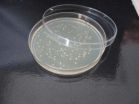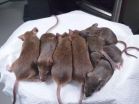(Press-News.org) When animals like dogs or rats sniff one another, there might be more going on than you'd think. Research reported in Current Biology, a Cell Press publication, on March 7th finds in rats that those sniffing behaviors communicate information about an individual's social status. In those encounters, more dominant rats act as primary sniffers, while subordinate sniffees actually slow their breath.
"We know that rats and other animals can communicate through vocalizations, physical contact, odors, and also visual displays," says Daniel Wesson of Case Western Reserve University. "To find that there was an undiscovered form of communication these animals had been using right in front of us this whole time was truly a neat experience."
Of course, the animals do use sniffing to smell each other. But Wesson suspected that wasn't the whole story. After all, it takes very little sniffing for a dog to pick up the scent of another dog. Why, then, do they sometimes sniff one another so vigorously? And why might those sniffing exchanges lead to a fight in some cases but not others?
In the new study, Wesson used radio telemetry recordings of nasal respiration in rats to find that when one rat sniffs in the direction of another, the recipient of that attention will respond by slowing their own sniffing rate, as if to say "don't mind me." Further investigation showed that the direction of those interactions depended on the relative size and social status of each of the two animals. In the event that a smaller subordinate failed to lower their sniffing rate appropriately, the more dominant partner would often lash out aggressively.
Those sniffing exchanges continued even in animals unable to smell but could be eliminated by treating animals with oxytocin, a chemical sometimes referred to as the "love hormone."
Wesson says it is likely that the animals are communicating conflict avoidance and appeasement signals in their decisions to sniff or not to sniff. It's not unlike the way a male primate beats his chest to demonstrate superiority while juveniles in his presence bow down in submission.
That sniffing is used not only to collect but also to convey information highlights the complex social lives of animals. "It opens the door to a totally new line of understanding complex, microstructured social behaviors," Wesson says.
INFORMATION:
Current Biology, Wesson: "Sniffing behavior communicates social hierarchy."
Sniff, sniff. What did you say?
2013-03-07
ELSE PRESS RELEASES FROM THIS DATE:
When food is scarce, a smaller brain will do
2013-03-07
A new study explains how young brains are protected when nutrition is poor. The findings, published on March 7th in Cell Reports, a Cell Press publication, reveal a coping strategy for producing a fully functional, if smaller, brain. The discovery, which was made in larval flies, shows the brain as an incredibly adaptable organ and may have implications for understanding the developing human brain as well, the researchers say.
The key is a carefully timed developmental system that ultimately ensures neural diversity at the expense of neural numbers.
"In essence, this ...
Using human brain cells to make mice smarter
2013-03-07
VIDEO:
What happens when human brain cells that surround and support neurons are implanted into the brains of newborn mice? Researchers reporting in the March 7th issue of the Cell Press...
Click here for more information.
What happens when human brain cells that surround and support neurons are implanted into the brains of newborn mice? Researchers reporting in the March 7th issue of the Cell Press journal Cell Stem Cell recently found that such mice had enhanced learning and ...
Persistence pays off in solving hemophilia mystery, showing curiosity drives discovery
2013-03-07
An Australian researcher has found the third and final missing piece in the genetic puzzle of an unusual form of hemophilia, more than 20 year after he discovered the first two pieces.
Professor Merlin Crossley, of the University of New South Wales, and his international team studied the blood-clotting disorder, hemophilia B Leyden, which is unusual because symptoms improve after puberty.
The results, published in The American Journal of Human Genetics, explain how more than half of the cases of this rare, hereditary bleeding disorder occur, and could help improve understanding ...
American Academy of Microbiology releases resistance report
2013-03-07
What do cancer cells, weeds, and pathogens have in common? They all evolve resistance to the treatments that are supposed to eliminate them. However, researchers developing the next generation of antibiotics, herbicides, and anti-cancer therapeutics rarely come together to explore the common evolutionary principles at work across their different biological systems. The new American Academy of Microbiology report "Moving Targets: Fighting Resistance in Infections, Pests, and Cancer" concludes that scientists working on different kinds of treatments have much to learn from ...
Dual systems key to keeping chromosomes intact
2013-03-07
USC scientists have discovered how two different structural apparatuses collaborate to protect repetitive DNA when it is at its most vulnerable – while it is being unzipped for replication.
The centromere—the center of the "X" shape of a chromosome—contains repeated DNA sequences that are epigenetically coded to attract so-called heterochromatin proteins. This protects the structure to ensure that the chromosomes separate properly. If the heterochromatin is lost (due to mutations in the cell), the repetitive DNA becomes vulnerable to rearrangements and recombination. ...
New hypothesis: Why bacteria are becoming increasingly more resistant to antibiotics
2013-03-07
According to his theory, bacteria that are non-resistant to antibiotics acquire said resistance accidentally because they take up the DNA of others that are resistant, due to the stress to which they are subjected.
A University of Granada researcher has formulated a new hypothesis concerning an enigma that the scientific community has still not been able to solve and which could revolutionise the pharmaceutical industry: Why are bacteria becoming increasingly more resistant to antibiotics? His work has revealed that the use of antibiotics can even cause non-resistant bacteria ...
New gender benchmarking study: India is making slow progress in advancing women in S & T
2013-03-07
Delhi, March 7, 2013 - In the first gender benchmarking study of its kind, researchers have found that numbers of women in the science, technology and innovation fields are alarmingly low in the world's leading economies, and are actually on the decline in many, including the United States. India's low overall ranking in the study shows slow progress despite women friendly policies which have been in place for a number of years.
The full gender benchmarking study maps the opportunities and obstacles faced by women in science in Brazil, South Africa, India, the Republic ...
New gender benchmarking study: South Africa ranks low on women participating in STI
2013-03-07
Cape Town, March 7, 2013 – In the first gender benchmarking study of its kind, researchers have found that numbers of women in the science, technology and innovation fields (STI) are alarmingly low in the world's leading economies, and are actually on the decline in many, including the United States. For South Africa, results show that women have more opportunities available to them than ever before, however, their participation in the science, technology and innovation workforce remains low.
The full gender benchmarking study maps the opportunities and obstacles faced ...
Japanese researchers succeed in making generations of mouse clones
2013-03-07
Using the technique that created Dolly the sheep, researchers from the RIKEN Center for Developmental Biology in Kobe, Japan have identified a way to produce healthy mouse clones that live a normal lifespan and can be sequentially cloned indefinitely.
Their study is published today in the journal Cell Stem Cell.
In an experiment that started in 2005, the team led by Dr. Teruhiko Wakayama has used a technique called somatic cell nuclear transfer (SNCT) to produce 581 clones of one original 'donor' mouse, through 25 consecutive rounds of cloning.
SNCT is a widely ...
High BMI linked to heart attack, stroke in young women
2013-03-07
SAN FRANCISCO (March 7, 2013) —A nationwide study of women in Denmark who are of child-bearing age finds that those who are obese appear to have a much greater risk of heart attack or stroke, according to research being presented at the American College of Cardiology's 62nd Annual Scientific Session.
In fact, women with a high body mass index (BMI)—a measure of the body's fat content—that is indicative of obesity were twice as likely as those of normal weight to suffer a potentially life-threatening heart attack or stroke within just four to five years following childbirth. ...



